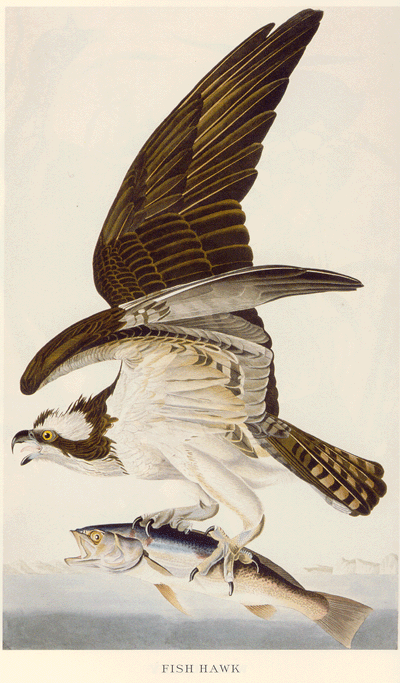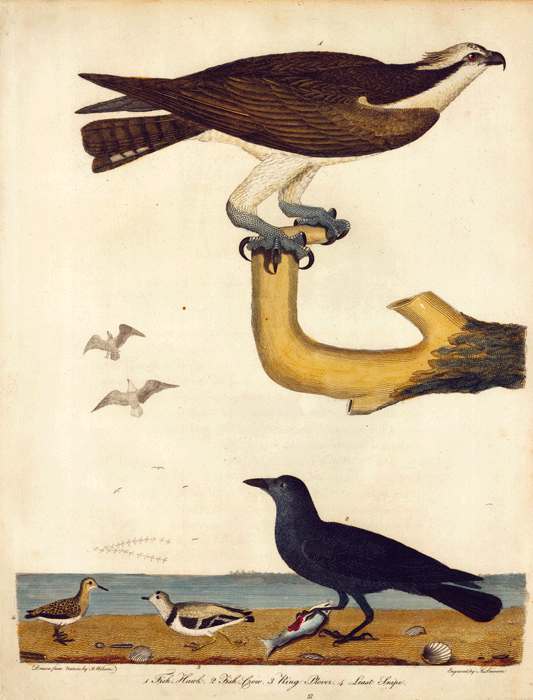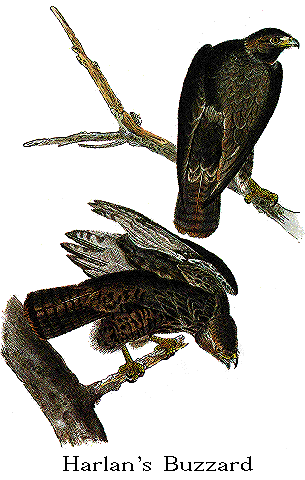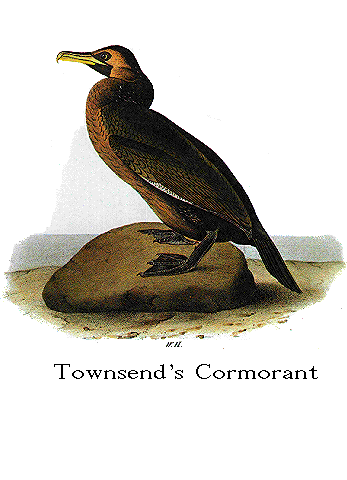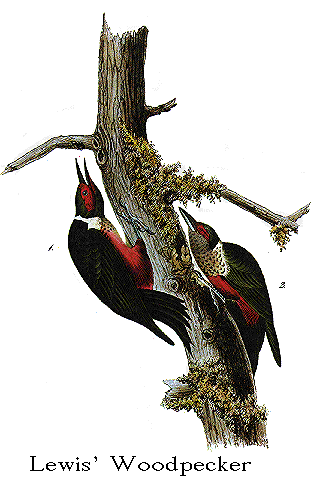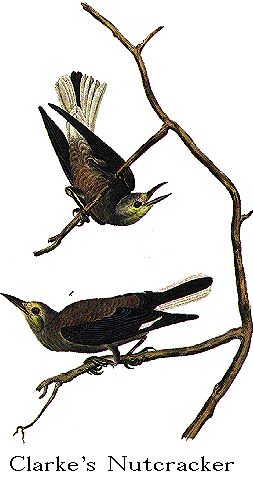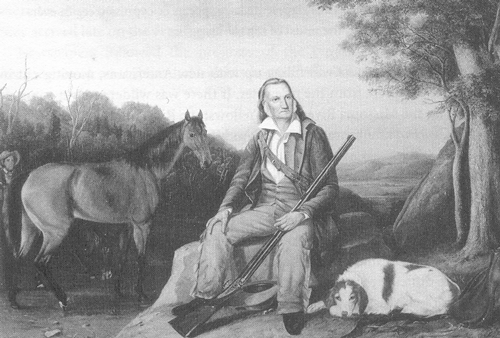 |
John James Audubon – A Bird’s-eye View |
I was asked to write a review of the recently published biography of Audubon. I enjoyed the book so much I got a bit carried away with myself. So here's the review, and then a look at Audubon's life from a slightly different angle.
Richard Rhodes’ most remarkable biography of Audubon (John James Audubon--The Making of an American, 2004, Alfred A Knopf) is, above all else, a love story. It’s a story of Audubon’s love for birds, his wife, and his adopted country—the fledgling United States.
Aside from the love stories, the book offers a feast of both natural history and whatever we call history that isn’t “natural history.” Rhodes gives us an intimate feel for what life was like back then, more through the details than the “big picture.” How many bags of gunpowder, pounds of ground arsenic (to preserve bird skins), and flints (for your flint-lock rifle) did you need to bring to the field to collect and draw birds?
We learn how the young country expanded west of the mountains—the first step was mostly floating down the Ohio River from Pittsburg to the Mississippi and New Orleans. (This was a one-way trip, so the boats that couldn’t be outfitted for ocean travel were disassembled and the wood used in construction.) We learn of the economic depression that swept the young country with the blockades before and during the war of 1812 and its impact on Audubon. (If history had been presented like this in high school, I might have paid attention!) We discover how significant disease was, and how fast the landscape was changing even early in the 1800s.
Naturally, the countryside and its wildlife are the principal backdrop to the story of Audubon’s life. Audubon arrived in a land where humans were just beginning to alter the world around them, but had not yet come to dominate and overwhelm the entire landscape. We read of market hunters shooting 48,000 Golden Plovers in a single day in New Orleans, Carolina Parakeets “abundant beyond description” along the Missouri River near Ft. Leavenworth, Kansas, (who would have imagined them that far north?) and the now-probably-extinct Eskimo Curlews in the Gulf of St. Lawrence seemingly as common as Passenger Pigeons.
Rhodes paints a detailed portrait of John James as a rather mercurial and most outgoing man. His mood swings were dramatic, perhaps never more so than when he was in England—well received by the intelligentsia, successfully working on the publishing of The Birds of America, but 4,000 miles separated from Lucy, his "dear friend" and wife, and trying to figure out how they could be together.
He was nothing if not flamboyant. When he taught dancing in Louisiana, he was quite the rage. A member of his crew on the expedition to the Gulf of St. Lawrence, described him as "a nice man, but Frenchy as thunder."
Audubon got around—from Philadelphia to New Orleans and out to the Montana-North Dakota border; from Florida to the Gulf of St. Lawrence, and over to Europe, where he hustled his life’s project—The Birds of America. Along the way, over nearly four decades, he seemingly met everyone there was to meet in the young country.
A birder reading this book will recognize many whom Audubon met as names of birds that might be on his or her life list—Wilson’s Plover, MacGillivray’s Warbler, Bewick’s Wren, Henslow’s Sparrow, Swainson’s Hawk. Most of these people played pivotal roles in Audubon’s life and their namesake birds were illustrated in The Birds of America.
The book is a rich and rewarding delight. If you have a birder in your life with even the slightest twitch of an interest in American history—both natural and the other kind—make sure this is under the Christmas tree next month!
Below, I have put together a sort of a Cliff Notes summary of Rhodes’ book, illustrated with the Audubon’s own (when available) plates of these birds and a description of how their human eponyms mattered in Audubon's life. (Click here to visit National Audubon's website where you can view all the plates.)
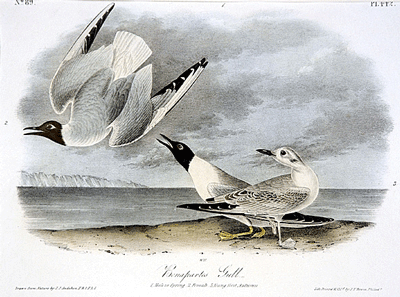 |
Bonaparte's
Gull The
Bonapartes, both Napoleon and his nephew Charles (for whom the gull is
named), featured significantly in
Audubon’s life—the emperor indirectly, and the nephew as a close
friend. |
| John James Audubon,
born Jean-Jaques, was
the illegitimate son of a wealthy merchant sea captain. He was born in
1785 to a French servant on his father’s sugar plantation in Haiti and grew up in
France with his father and his father’s most understanding
wife—his illegitimacy (as well as that of his half sister) was a closely
guarded secret within the family. Correctly anticipating the revolution soon to happen there, Audubon père sold the Haitian sugar plantation and sunk the proceeds of the sale into a farm, Mill Grove, on a tributary of the Schuylkill River north of Philadelphia. It was to this property that the young Audubon was headed to establish himself in the new country. More on Charles Bonaparte later on. (Until very recently, the Mill Grove plantation was owned by Montgomery County and run as a historical site. It is now a National Audubon Society education center, apparently with many artifacts of Audubon's life on display.) |
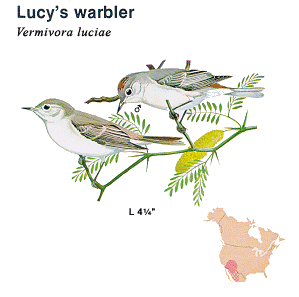 |
Lucy's Warbler - Audubon's Wife and "Dear Friend" OK, this is a total stretch--it's not an Audubon painting
and the "Lucy" is not Lucy Bakewell Audubon, but Audubon
didn't cooperate here and name a bird after his beloved wife, so what was
I supposed to do? Without
Lucy, there is no story. The namesake for this bird was the only daughter
of Spencer Baird (1823-1887), a preeminent American Ornithologist and
Secretary of the Smithsonian Institution. Baird and Audubon were friends,
so there's a tenuous connection at least. |
| Because
his own financial situation was not particularly flush, his father had
refused to consent to the marriage until Audubon became self sufficient.
John James had had some formal art training in France but it hadn’t progressed very far, so he kept at it and honed his skills on his own. It was at Mill Grove that, in his frustration to give life to his bird portraits, he invented a drawing board that permitted him to pose his birds in natural postures. The board had a grid drawn on it and wires protruding. It was set up vertically, so he could arrange the bird the way he wanted and, thanks to the grid visible behind the posed bird, get the relative proportions of the bird’s body part just right. The farming and lead mine didn’t pan out, but the courtship of Lucy Bakewell did. They were married in 1808 (it's not clear if he had his father's blessing) and headed out to begin their lives on the American frontier, which at that time was the Ohio River and the Mississippi. Audubon and Rozier had clerked in the New York offices of Lucy’s merchant uncle to learn the trade, and so they opened a business in Louisville. Lucy had their first son, Victor, in 1809. The next year, with competition a bit stiff for the fledgling merchants, and Audubon wanting to move further from the crowded Louisville, they decided to move. They were going to set up a business in New Orleans, but naval blockades (the War of 1812 was brewing) made that impossible. So they bought and borrowed some merchandise and moved 125 miles downstream to Henderson to set up another general store. They made a go of it in Henderson for a number of years, until Audubon decided to build a steam-powered mill on the banks of the river. This turned out to be a real disaster and left the family in bankruptcy. In 1810, Audubon spent his first time away from Lucy and their son, going down the Ohio and up the Mississippi, where he lived with the Osage Indians for some months. From this point on, separations from his family would become his way of life. Lucy soldiered on, often teaching to keep herself and their two sons fed while Audubon roamed the woods, collecting and drawing the birds of the American continent. Their second son, John Woodhouse, was born in 1812. By 1817 the economy was in the tanks and Audubon was in trouble with the mill project, which was not quite finished. 1819 saw the first great American financial disaster. Audubon had bought into a steamboat with the engineer that he brought in to build the mill. The engineer took off with the boat and left him in the lurch with all sorts of debts. So the family sold everything, including Lucy’s silver, and Audubon headed off on foot to Louisville to find work. He ran into creditors there and was thrown into jail. He got out, but this bankruptcy haunted him pretty much for the rest of his life. This is when he started painting portraits to keep the family alive. Their third child, Rose, did not survive infancy. Audubon went off to Cincinnati, where worked about a year as an artist at the Western Museum. He left in 1820, never having received his full wages. This was a recurrent theme in his life. At this point he had decided to publish his work and was gearing up to travel down the Mississippi to cover the territory southwest of the Mississippi. He got on a flatboat with nothing but his art supplies, his violin, a tattered translation of Linnaeus as his field guide, and 18 yr-old assistant James Mason. They arrived in New Orleans 7 Jan 1821. He was painting and teaching art while trying to get letters of introduction and the appropriate permissions to get him west. He was pretty much broke and at odds with Lucy. She needed money and he didn’t have any to send her, so, in search of a new market he went up to Bayou Sarah 125 miles north of New Orleans, where he continued teaching and continued having problems collecting payment. He finally got someone to pay and sent money up to Henderson to let Lucy and sons come down river to join him. In 1822 Audubon went up to Natchez and teamed up with John Steen, an artist with an established portrait painting business. This was his first experience with oil painting in a big way. However successful the venture was, it was eating into his birding time, and he didn’t like grinding the pigments for his paints, so he left Steen in 1823 to devote himself to his book. By 1823
we know he was thinking of taking his portfolio to Europe for publishing.
He and Victor, now about 13, went up to Louisville, where Victor would
clerk with a family relative, and Audubon began in earnest to earn money
for the trip to Europe. Lucy and John Woodhouse remained in Bayou Sarah,
where Lucy continued teaching. |
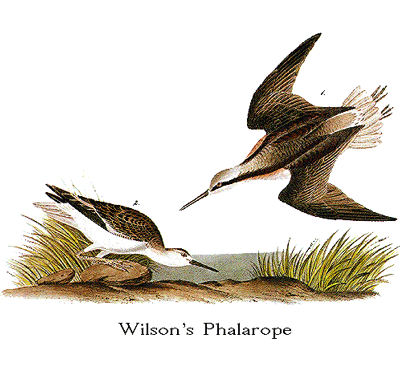 |
Wilson's Phalarope - The Father of American Ornithology Alexander Wilson is the father of American Ornithology. He was an émigré from Scotland, where he had been a master weaver and itinerant peddler. He came to the United States in 1794 and set up as a schoolteacher just a few miles south of Mill Grove. Shortly thereafter he left his teaching job and began to wander through the countryside, collecting and painting birds, producing a multi-volume treatise entitled, appropriately enough, American Ornithology. He had experience in publishing and somehow managed to produce his books as he traveled alone, selling subscriptions as he went to finance his travels and research, just as the much more gregarious Audubon would do a couple of decades later. In 1810, he arrived in Louisville and met Audubon, about whom he had heard in Pittsburg. He showed Audubon his books and was just about to sell him a subscription when Rozier, Audubon’s travelling companion and partner in the general store, told him (in French) not to bother, because his (Audbon’s) paintings were better than Wilson’s. |
|
Audubon then showed Wilson his own paintings, which were indeed
artistically superior to
Wilson’s. At this point Audubon had not yet
decided to publish his work, which probably was a relief to Wilson. Wilson spent several days with Audubon in the Louisville area before heading off to continue his lonely ornithological peregrinations. Both men were impressed with each other. Wilson noted birds in Audubon’s drawings that he hadn’t encountered, and Audubon kept a draft copy of Wilson’s work as a checklist, and continuously had to track down the latest volumes of Wilson’s work as a reference as his work progressed. He had even offered to let Wilson use his illustrations, but Wilson didn’t want to share the limelight and so declined. He met Wilson one last time in Philadelphia a year later. Wilson died of dysentery in 1813, with the 8th volume of his Ornithology in press. While Wilson is the father of North American ornithology, Audubon is the undisputed father of artistic ornithology. His art was the first to portray birds in natural poses, although some seem quite contrived. The larger birds are often curved back on themselves because he was painting them in life size and the largest paper he had to work with was about 26" x 38 inches. He also included plants and natural background scenes to place his birds in context and to enhance the esthetic appeal of the drawings. Many of these "mise-en-scene" backgrounds were painted by his assistants or, later in the project, by one of his sons. In 1812 Audubon painted his first bird in flight--a Whippoorwill. This was a rather radical departure from the standards of ornithological illustration, primarily because the in-flight depictions necessitated foreshortening. This, in turn meant that measurements could not be taken from the illustrations. This lack of accuracy lessened the scientific value of the illustrations, the argument went. In the two prints below, one can see the difference between Audubon's artistic rendering of an Osprey (on the left) and Wilson's adequate, but much less dramatic, illustration of the same species. We also notice that Audubon's placement of birds in natural scenes was not his own innovation, as Wilson has his Osprey on a beach, with stuff going on around it. |
|
|
|
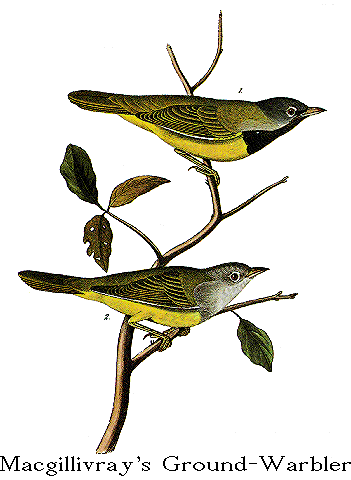 |
MacGillivray's
Warbler In 1825 Audubon went back to Bayou Sarah and set up a school, adding fencing and dancing to the arts curriculum. He was saving for his first trip to Europe, where he planned to have his book published. Finally, in 1826 he left for New Orleans and later that year boarded the Delos for Europe. After a 64 day crossing he landed in Liverpool in July. His first port of call was Edinburgh, where his letters of introduction opened a few important doors. He was quickly accepted by the local intelligentsia, and the doors just kept opening. He began showing his works at exhibitions and painting to raise money. He was accepted into scientific societies without the rancor he had experienced in Philadelphia. He found an engraver and began selling subscriptions with good success. He made it to London and found a new engraver (the work of his first, Lizars, was unacceptable). The Havells (father and son) would publish the whole rest of his work. His engravings were published in groups, or numbers, which current subscribers would receive as they were published. Audubon used his artistic sense to set up esthetic, rather than taxonomic sequences of birds to be included in each number. |
|
By 1828
he was fairly comfortably established, selling oil paintings and
subscriptions (he had three numbers of Birds
of America published) and the struggle to reunite with Lucy was
underway. |
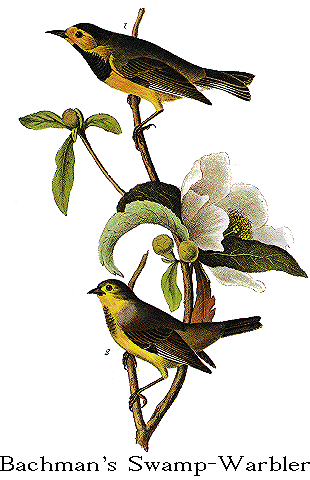 |
Bachman's Warbler -Southern Hospitality and Two Wives for Two Sons In Charleston, SC, through
one of his contacts, he happened to meet the Reverend John Bachman, an
ardent amateur naturalist who grew up in upstate NY and while at school in
Philly in 1804 spent time in Bartram’s botanical gardens, as had
Alexander Wilson. Bachman and the whole Audubon family became dear
friends. Both of the Audubon sons wound up marrying Bachman’s daughters,
and Bachman and Audubon wound up collaborating on a mammalian counterpart
to Birds of America. |
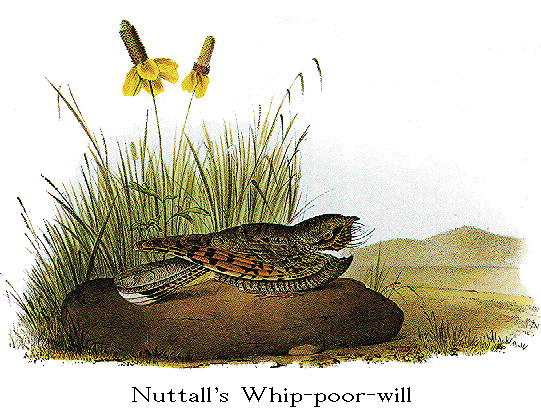 |
Nuttall's Whippoorwill (Common
Poorwill) -North to the Bay of Fundy Thomas Nuttall (1786-1836)
was an English botanist and ornithologist who came to America when he was
22 and played an important role in natural history studies in the young
country.
|
| In 1833 he had a rather tragic-comic
encounter with a Golden Eagle, a species he really needed to draw. He came
upon one that had been caught by a fur trapper and purchased it. He toyed
with setting it free, but decided he needed the drawing, so he set about
trying to kill it—no small task, as it turned out. He tried killing it
first by setting a coal fire under its cage in a closet with blankets all
around the cage, with the expectation that carbon monoxide would kill it.
After many hours, he peered into the cage and saw the eagle glaring back at
him. He and his son were already feeling ill the room, so they abandoned
the attempt and the next day added sulphur to the rekindled fire. Again,
all they got from the eagle was a glare when they checked on the progress
of their attempts to kill it. Finally, he had to resort to a stiletto
through the heart to prepare his bird for painting. Painting the eagle was an exhausting process, but the results spectacular. Audubon suffered a mild stroke after finishing it. Waiting for funds from Victor to fund an expedition to Labrador, he took Lucy back to New York City. In May he and son John headed up to Boston and on to Maine where they chartered the Ripley, a newly built, 100-ton schooner and headed north, crossing the Bay of Fundy in June. |
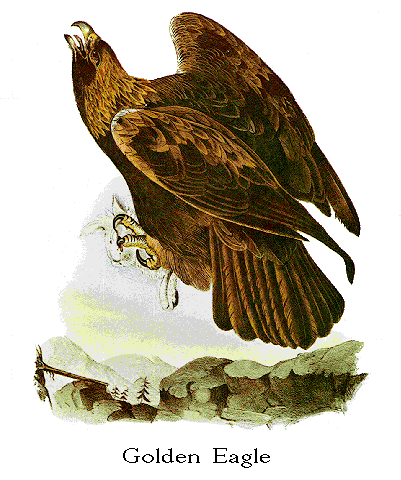 |
|
The abundance of wildlife and the extent of the human harvest they witnessed are inconceivable. Gannets, murres, and puffins filled the sky and waters. Seemingly infinite nesting colonies on rocky islands were harvested with adults clubbed to death to be used for bait and eggs harvested for food. In one season, a party of four men from Halifax took 400,000 eggs from the rookery. They broke all the eggs they could find so the breeding females would recycle and they could sell freshly laid eggs—no one wants to crack open an egg and find a chick that was about to hatch in the skillet! Once they got the females laying fresh eggs, they took them until the birds stopped laying. Audubon was depressed by the slaughter and realized that this level of harvest could not be sustained. |
Harlan's Hawk and Townsend's Cormorant - A vicarious trip to the far west. |
|
|
|
| Returning to the States in 1836, Audubon learned that Nuttall and John Kirk Townsend had just returned from west of the Rockies with 100 new species, none included in Wilson’s work. Audubon for years had been trying to arrange an expedition to the far west, but never pulled it off. This was his chance to include western birds in The Birds of America, but his arch enemy Ord refused to let Audubon even see the specimens. So Audubon went up to Boston, and got Nuttall's permission to work with the skins. With the help of Richard Harlan (Audubon named the western Red-tailed Hawk subspecies in his honor) and some other members of the Academy and the financial backing of his New Jersey patron Edward Harris, he wound up buying the duplicates from the collection and including them in the Birds of America. |
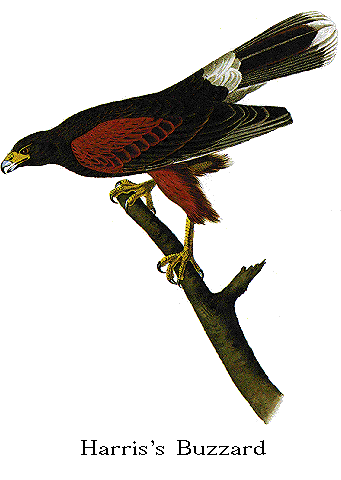 |
Harris' Hawk -A Visit to the Republic of Texas He and son John went down to Charleston and spent the winter with the Bachmans. Here Audubon worked on drawing from the Nuttall expedition. In 1837, as they headed down to New Orleans, they crossed paths with the Cherokees that were being forced to march west along the "Trail of Tears." In March of 1837 his old friend and patron Harris joined him and the expedition got on a navy cutter headed down the gulf coast to the new nation of Texas. There they collected both birds and mammals (they were already at work on the Viviparous Quadrupeds of America) and met President Sam Houston. Audubon returned from the trip quite wasted—12 pounds lighter. His days of hard field work were almost over. He was 52 and had only a few teeth left. Later that year son John married Maria Bachman and they all headed over to join Lucy in London to work on publishing there, Audubon fairly satisfied that his work was done. There was yet one more major expedition in store for him, however. As he sailed for England, he was fairly flush with cash. He left brother-in-law Berthoud in NY to continue serving as his agent—there were many subscriptions to collect.
|
| Clark's Nutcracker and Lewis's
Woodpecker -In the footsteps of Lewis and Clark |
|
|
|
Audubon did meet Captain
William Clark late in Clark's life, and followed the trail of the famous western
explorers on the last expedition of his life. Sometime in the
1840s he went up the Missouri to
Fort Union, where the Yellowstone feeds into the Missouri, near the
Montana-North Dakota Border.
(Clark's Nutcracker was named by Alexander Wilson,
after Thomas Jefferson sent Wilson the specimen that Clark had collected in
Washington.)
In
1843, unable to secure government funding for a trip west of the Mississippi, he
decided to finance the expedition himself and headed west for his last excursion
into the wild.
On
the way west he passed through Henderson and saw the ruins of his home there,
and commented on how the Ohio valley was filling up—no more elk and buffalo
grazing along the banks of the river. Suburban sprawl, in its 19th
century incarnation, was already upon the land!
He
got to St. Louis and traveled up the Missouri, retracing Lewis and Clark’s
route as far as the North Dakota-Montana Border, where he stayed for the summer
at Ft. Union, where Yellowstone River feeds into Missouri.
Along
the way he saw Indians living in squalor and was not as compassionate as he had
been on seeing the Cherokees in Alabama. One deckhand on an American Fur Trading
boat brought smallpox up the Missouri and 17,000 Indians died.
He
saw Carolina Parakeets “abundant beyond description” near Ft. Leavenworth
and marked the line above which European honeybees had not yet expanded.
European honeybees expanded west a year or two faster than the species that
introduced them, and consequently were called “white-man’s flies” by the
Indians.
He
commented on needless killing (one soldier spent his nights shooting wolves from
the fort’s parapets) and was pleased to note that when soldiers were sent out
to kill some buffaloes, they were told to kill 3 and
no more, so he thought he’d made his point,
He collected and painted
during the summer, but returned with a disappointing series of
mammals—especially the smaller species. It was hard to take one’s eyes and
minds off the big game with all buffalo covering the landside. His last tooth
fell out before returning to St. Louis.
 |
He
returned to Minniesland (the family home recently built on Manhattan) for the
final time and set up a teepee he had brought back from his trip west. The
property, located at the foot of 156th St, was home to quite a menagerie with a buffalo cow and calf, elk, badger,
deer, fox, and a host of birds. Audubon Avenue now runs from
165th to 193rd Sts in New York. |
In 1844
he sold last 5 numbers of the Octavo editions of BOA to 11,000 subscribers, which
netted him $840,000 (current dollars) and should have set up the family for a
long time, but financial problems that plagued him throughout his life persisted
and the family never enjoyed the stability such an income should have provided.
Audubon died in 1851 after a most remarkable 66 years.
Top - Home
- Ornithology - Habitat Fragmentation - Neotropical
Birds - Birds of Prey -
Graduate Students - Conservation Organizations -
Publications
